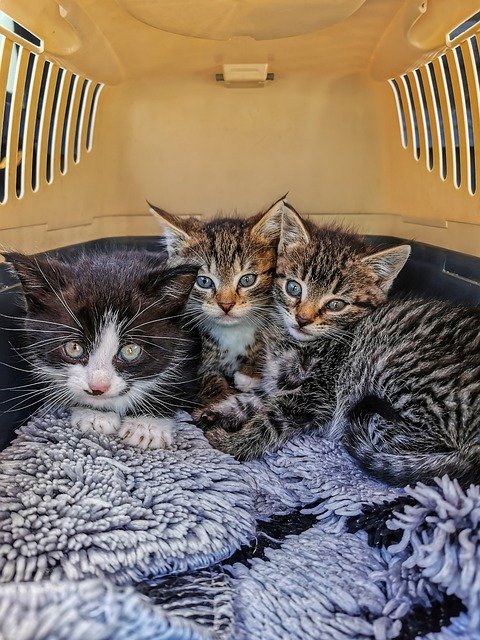Choosing between a hard or soft cat carrier isn’t as easy as it seems. While your decision should be based on needing a box to safely carry your cat while traveling, it should also focus on the specifics.
Image by Gundula Vogel from Pixabay
Why exactly will your cat need a ride on a carrier? Remember, taking your kitty to the vet may require a different carrier than when you’re traveling cross-country with her in your car.
Today, we’ll be helping you decide between a hard and soft cat carrier by taking a look at each item’s advantages. Once you’ve made your decision, you can proceed to read some great tips for loading your cat into her carrier for a completely safe and hassle-free transportation.
The Bases for Choosing Cat Carriers
Here are some considerations for picking a hard or soft cat carrier:
1. Kitty’s Personality
Unless you’re flying on an airplane with your feline friend, it is perfectly okay to choose a carrier based on your cat’s personality.
Traveling tends to make cats anxious and aggressive, causing them to scratch, bite, or claw at the walls of their carrier. In that scenario, you’re better off choosing a hard carrier to withstand the onslaught. On the other hand, soft carriers made of fabric may be more ideal for even-tempered felines.
2. Carrying Capacity
If you can’t physically carry your cat’s carrier, it isn’t going to be of much use for traveling. Some hard carriers are heavy even before they’re occupied. Although the same can be said of some soft carriers, many options usually have an additional handle or shoulder straps to help with weight distribution.
3. Traveling by Airplane
Traveling by airplane means referring to the airline’s regulations. In some airlines, you can fly with your pet on the aircraft’s cabin, which is best done with a soft carrier pushed under the seat fronting yours. For traveling in the aircraft’s hold, a heavy-duty hard carrier would be the ideal choice.
Hard Carriers
A lot of cat owners feel more comfortable placing their pets inside a hard carrier since it offers sturdier protection. It’s also generally longer-lasting than a fabric carrier. Let’s take a look at what else this specific carrier brings to the table.
Hard Cat Carrier Advantages
Below are the following areas hard cat carriers excel at:
1. Robust Structure
Hard cat carriers are stronger and more durable than soft ones. They are often made of plastic and have either a plastic or metal grill at the front.
2. Easy Access
Some hard carriers are front-loading, which means you can only take your cat out of the box after unlocking or unhitching the front grate. Others offer a top-loading feature, which allows you access by unscrewing or unclipping the carrier’s top from its bottom. Top loaders allow easier access and may even enable vets to examine the cat inside her carrier.
3. Better for Difficult Cats
If your cat becomes typically nervous or aggressive when traveling, then a well-constructed hard carrier should be a better fit for her. If she also happens to be an escape artist, pick a hard carrier with a metal gate instead of a plastic one.
Soft Carrier
Soft cat carriers are all about comfort. Unlike hard carriers, these pet boxes allow your feline to sit or lie down easily. Here’s what else makes them a great choice for relatively placid cats.
Soft Cat Carrier Advantages
A cat that remains mostly calm while traveling is a better fit for a fabric carrier. Here’s why:
1. Lightweight
Soft cat carriers are much easier to carry than hard ones. Many of them also come with additional shoulder or handle straps to distribute weight evenly.
2. Easy Access
This is an advantage the fabric carrier shares with top- and front-loading hard carriers. Most soft pet boxes have multiple openings to help owners get their cats in and out easier.
3. Paperwork Pockets
Packing can be a huge headache for anyone, but especially for someone traveling with pets. Fabric carriers usually have paperwork pockets to make traveling by aircraft easier. You can store treats and documents in this outside compartment and not have to dig through your carry-on to find them.
4. Expandable Area
Soft carriers tend to have an expandable area that stretches out into a “patio.” We all know how our cats love stretching. This expandable area should allow them to do that while still remaining within the safety of the box.
What to Keep in Mind for Both Options
If you find it difficult to bend or lift, consider the weight and size of the pet carrier and whether lifting and walking with it will be possible. Some can even have wheels added on, and others may come with alternate straps.
Your cats should also be able to move around and lie down relatively easily inside the carrier. Generally, the box should be one and a half times bigger than the cat for this to happen. If you get anything bigger, your cat probably won’t be too happy with it since she prefers smaller spaces. Plus, it also means she’ll be slipping about and sliding around inside.
More Tips for Cat Owners